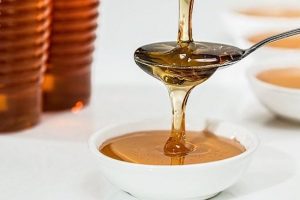DIY - Tutorials, Food
Honey, the sweet gold for skin and soul

Jan
Honey has been cultivated for thousands of years and is valued not only for its natural sweetness, but also for its healing and nourishing properties. The Sumerians already used honey as an offering to their deities, and Ramses II rewarded special achievements of his officials with honey. In Europe, the history of honey is somewhat more recent: as honey was the only known sweetener for a long time, people began weaving beehives from clay and twigs around 2000 years ago to house the bees and thus obtain the valuable honey.ds
Honey for sweetening
Honey is particularly popular as a sugar substitute (which is actually a paradox, as sugar was developed as a honey substitute for sweetening!), as it is sweeter than sugar and of course much healthier. Honey also has a great effect in baking: baked goods sweetened with honey turn a beautiful golden colour and have a more caramel-like aroma than the sharp sweetness of refined sugar.
Spoilt for choice - which honey is the right one?
As a general rule, honey should be organic, raw if possible and come from the region. These characteristics ensure that the quality is as good as possible. Depending on the area of use and flavour, it then depends on which blossom the bees use to produce the honey.
Reiner Acacia honey is collected from the sweet-smelling blossoms of the false acacia tree. In Switzerland, there are only pure acacia forests in Ticino, which is why Swiss acacia honey should always come from Ticino. Acacia honey is golden yellow in colour and liquid as long as it is fresh. This is because the fructose content of the honey is higher than the glucose content.
The blossoms of chestnut trees also provide thick, sweet nectar, which is known as (Sweet) chestnut honey is well known. Chestnut honey has a spicy and slightly bitter flavour. Like chestnut, chestnut honey is thinner and the consistency is still liquid, but already thicker than acacia honey. Chestnut honey goes well with cheese and fruit, on yoghurt and ice cream, or as a spread on bread.

A very popular variety is the Forest honey for sweetening teas in winter. Strictly speaking, this does not consist of nectar at all, but of so-called honeydew. Honeydew is a sugary metabolic product of certain types of aphids, which the bees find in the form of sweet droplets on the leaves and needles of trees. Forest honey is tangy and its colour ranges from golden yellow to reddish brown.
A very special honey is manuka honey, which is collected by bees in New Zealand from the manuka bush. This dark and rather bitter than sweet honey is not only used for sweetening, but above all for healing, namely for infections and inflammations in the mouth and stomach, as well as for skin care, for example in the treatment of acne and scars. Manuka honey is categorised into different grades (numbers) depending on its intensity and effectiveness. The higher the number, the more effective (and more expensive) the honey.

Honey for the skin
Even Empress Cleopatra used honey to care for her legendary beauty. Honey nourishes and moisturises, soothes reddened skin and also has an antibacterial effect.
A simple honey mask goes like this: Cleanse the skin thoroughly and apply honey to clean skin. Leave on for about 20 minutes and remove the rest with warm water.
Honey can also be applied to rough areas such as lips, elbows, burns, abrasions and sunburnt areas.
Bathe in honey like Empress Cleopatra: Mix a small amount of milk or whipped cream with 2-3 spoons of honey and, depending on your mood, you can also add a few drops of essential oil. Lavender relaxes and creates clarity, sage warms when hypothermic and cools when overheated, orange and citrus fruits relieve depressive moods and put you in a good mood. Stir into the warm bath water and enjoy.